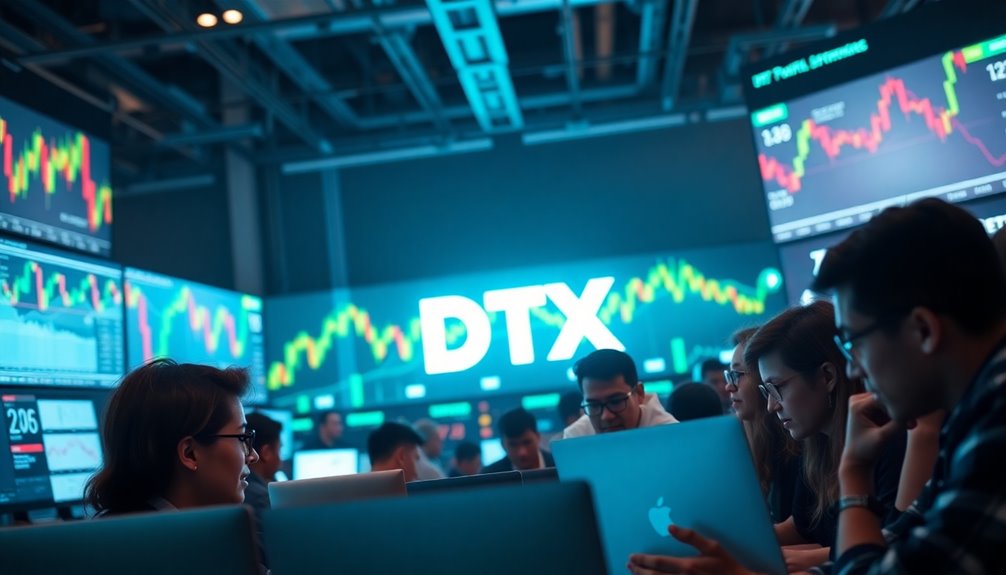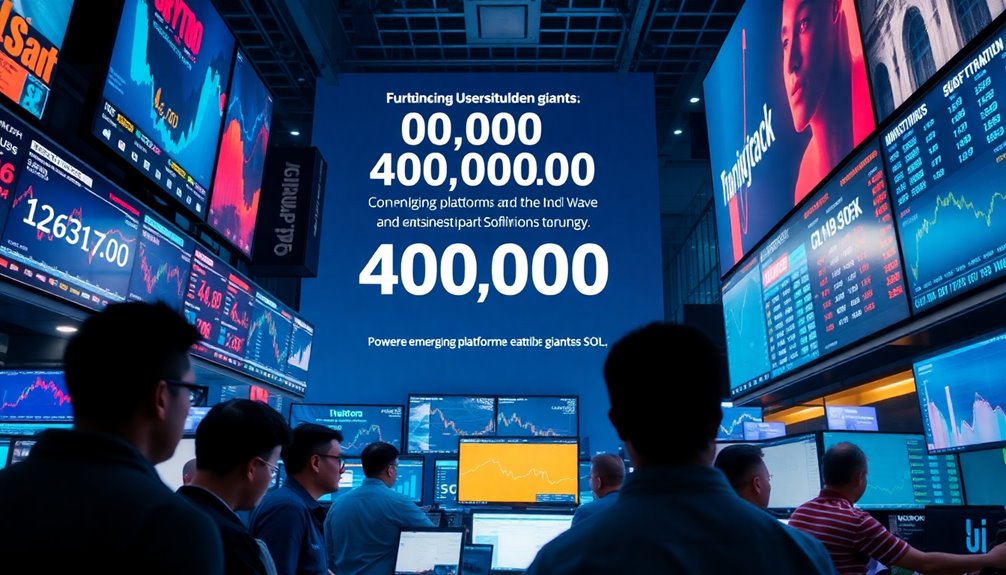DTX Exchange's impressive growth, attracting 400,000 traders pre-launch, hints at a potential shake-up in the DeFi scene. With over 300,000 wallet addresses registered and a transaction speed of 100,000 per second, it's poised to challenge Solana's current dominance. Solana processes 65,000 transactions per second and boasts low fees, but DTX's diverse offerings and user engagement might sway traders seeking better options. As DeFi evolves, competitive platforms like DTX could reshape your investment strategy. Stay tuned to discover how these shifts could influence your position in the DeFi market.
Key Takeaways
- DTX Exchange attracted 400,000 traders pre-launch, indicating significant market interest that could challenge Solana's user base.
- Operating on the VulcanX blockchain, DTX offers 100,000 transactions per second, surpassing Solana's capabilities.
- DTX's diverse trading instruments provide an appealing alternative for traders, potentially drawing users away from Solana's ecosystem.
- The DeFi market's projected growth of 46.0% could favor innovative platforms like DTX, increasing competition for Solana.
- Institutional adoption and advancements in DeFi technology may alter the competitive landscape, impacting Solana's dominance.
Overview of DeFi Growth

Decentralized finance (DeFi) is rapidly transforming the financial landscape, and it's hard to ignore its staggering growth. The global DeFi market was valued at USD 13.61 billion in 2022, and projections show it'll explode to USD 231.19 billion by 2030, growing at a remarkable CAGR of 46.0%. This rapid expansion stems from a rising demand for accessible, transparent, and inclusive financial services. With blockchain technology's flexibility, new financial instruments are emerging, eliminating the need for costly centralized institutions.
Key trends, like the rise of decentralized exchanges (DEXs) and yield farming, highlight how users can trade and earn rewards without intermediaries. North America leads the way, holding a 35.02% market share in 2022, driven by major players like Compound and Uniswap. Furthermore, the projected revenue in DeFi market is estimated at US$418.7m by 2024, showcasing continued interest and investment in this space.
The payments segment is expected to witness the fastest growth, propelled by secure cryptocurrency exchanges. As DeFi continues to democratize financial services, you'll see more opportunities for borrowing, lending, and trading directly on the blockchain, reshaping how you engage with finance.
The future looks bright for DeFi, paving the way for profound changes in the global financial ecosystem.
DTX Exchange's Rapid User Adoption

DTX Exchange is witnessing an impressive surge in user adoption, with a staggering 400,000 traders already attracted even before its official launch. This rapid growth isn't just a coincidence; over 300,000 wallet addresses have registered, indicating a strong interest from both retail and crypto enthusiasts. Early stages saw a remarkable increase, with 155,000 users joining, largely fueled by a shift away from Solana following the ETF rejection. The ongoing presale has also played a significant role, raising $10.19 million in its sixth stage and totaling $10.24 million overall. Early buyers are enjoying a 300% profit as token prices climbed from $0.10 to $0.12. The DTX Exchange operates on the VulcanX blockchain, boasting an impressive 100,000 transactions per second and offering a hybrid platform that combines decentralized and centralized features. As a result of its competitive performance, DTX is capturing the attention of wealthy traders who are looking for new opportunities in the crypto space. With more than 100,000 trading instruments available, including stocks, forex, and crypto, traders are drawn to its unified platform. As DTX continues to gain traction and attention on platforms like CoinMarketCap, it's clear that its user adoption is set to keep accelerating ahead of the anticipated launch in early 2025.
Solana's Competitive Advantages

As DTX Exchange captures attention for its impressive user growth, it's important to consider the competitive landscape, particularly the advantages offered by Solana.
One of Solana's standout features is its high throughput and transaction speed. With the ability to process up to 65,000 transactions per second in testing, and an average of 4,000 to 4,500 TPS in real-world scenarios, Solana far surpasses Bitcoin and Ethereum. Transaction confirmations occur in roughly 0.4 to 0.5 seconds, making it ideal for time-sensitive applications. Additionally, Solana has established itself as one of the most popular blockchain networks, attracting hundreds of cryptocurrency projects due to its competitive transaction fees.
Additionally, Solana's scalable architecture, built on a combination of Proof of Stake and Proof of History, supports both high transaction volumes and the development of decentralized applications without sacrificing security. The average transaction cost is just $0.00025, making it a cost-effective choice for users, especially in the NFT and DeFi spaces.
Lastly, while some criticize its level of decentralization compared to Ethereum, Solana maintains a secure and stable network. This blend of speed, low costs, and robust security underlines the competitive advantages that position Solana as a formidable player in the DeFi landscape.
Market Performance of DeFi Assets

The DeFi market is witnessing significant growth, driven by increasing user adoption and expanding asset offerings. With a market size estimated at USD 46.61 billion in 2024, it's projected to reach USD 78.47 billion by 2029, reflecting a robust CAGR of 10.98%.
However, the Total Value Locked (TVL) in DeFi platforms has seen a decline from USD 177 billion at the start of 2022, now resting at approximately USD 42 billion as of January 2024.
Despite fluctuations, DeFi companies are performing well financially. For instance, DeFi Technologies reported C$152.4 million in total revenues for the first nine months of 2024, showcasing strong growth. Additionally, the company experienced a record AUM of C$1.1 billion by November 2024, indicating its expanding influence in the market.
User adoption is soaring, with over 30 million users on MetaMask alone, marking a staggering 3,800% growth since 2020.
The availability of cryptocurrencies continues to expand, with nearly 9,000 listed for trade as of January 2024.
While the DeFi sector presents lucrative opportunities, it's essential to remain aware of the inherent risks, including vulnerabilities tied to leverage and liquidity.
Balancing growth and stability will be key to the future success of DeFi assets.
Innovations in DeFi Platforms

Innovations in DeFi platforms are reshaping the financial landscape, making decentralized finance more efficient and accessible. Advanced consensus mechanisms like Proof of Intelligence (PoI) and Solana's hybrid Proof of History (PoH) and Proof of Stake (PoS) allow the network to process over 65,000 transactions per second. This scalability means you can engage in high-volume trading without worrying about congestion.
Artificial intelligence is also making waves. The Artificial Intelligence Virtual Machine (AIVM) enables dApps to run AI workloads directly on the blockchain, improving risk assessment and predictive analytics. In fact, the use of Proof of Intelligence enhances network security while optimizing transaction processes.
You'll find AI-driven credit scoring making lending platforms more inclusive and efficient, while automated trading helps optimize your returns on decentralized exchanges.
Additionally, innovative financial instruments like liquid staking protocols and zero-interest borrowing are enhancing user experience. These features allow you to stake your assets while maintaining liquidity and borrow without high fees.
Governance is evolving too, with Decentralized Autonomous Organizations (DAOs) increasing community participation in decision-making.
Ecosystem Developments in Solana

Ecosystem developments in Solana are driving significant progress and engagement within the community. Despite leadership changes, including Cash Donda stepping down as Sherpa of Superteam, the community remains strong and committed. Transitioning to a Sherpa Emeritus role, Donda's last call highlighted the continuity of leadership focused on maintaining momentum.
Recent metrics show an 11.2% rise in development activity and a 4.2% increase in contributors over the past month, indicating vibrant developer engagement. The launch of new decentralized applications (DApps) and initiatives like grants and hackathons are further enhancing participation. Notably, Solana's Total Value Locked has grown significantly from $200 million to $9 billion in just two years.
Network performance metrics are impressive, with Total Value Locked soaring from $200 million to $9 billion in just two years. True transactions per second (TPS) have increased from 300 to 1,300, allowing the network to handle peak loads of 65,000 TPS with minimal fees.
Moreover, Solana boasts over 2,000 active developers, enjoying 83% year-over-year growth. Projects like Star Atlas are leveraging its robust infrastructure, while USDC and USDT are achieving new adoption heights, especially in places like Argentina.
This continuous growth positions Solana as a formidable player in the blockchain space.
Future Market Predictions

As the cryptocurrency landscape evolves, market predictions suggest substantial growth on the horizon. The global cryptocurrency market is projected to expand by $34. 5 billion from 2024 to 2028, with a compound annual growth rate (CAGR) of 16. 64%. By 2024, the market could reach USD 44. 29 billion, climbing to USD 64. 41 billion by 2029. Increased investment in digital assets and the rising acceptance of cryptocurrencies among retailers are driving this growth. Bitcoin’s price has seen a remarkable surge, hitting nearly $70,000 in late May 2024, with expectations to reach $77,000 by year-end. Solana is also anticipated to break through local resistance, targeting prices of $300 and $500 in the mid-term. The approval of spot ETFs and the upcoming halving event are likely to contribute to a bullish market. Furthermore, the historical data shows that previous halvings have led to significant price increases, which could further bolster Bitcoin’s value. Additionally, the upcoming Bitcoin halving is expected to impact mining profitability, potentially driving prices even higher. Ethereum rally approaching record territory, with the Ethereum blockchain undergoing upgrades to improve scalability and energy efficiency. This has garnered significant interest and investment in the Ethereum ecosystem, with experts predicting a surge in Ethereum prices. As more institutional investors and major financial institutions enter the cryptocurrency market, there is growing confidence in the long-term viability of digital assets, further fueling the projected growth of the cryptocurrency market. The potential for increased regulatory clarity and mainstream adoption could also contribute to the positive outlook for cryptocurrencies in the coming years. Furthermore, the decentralized finance (DeFi) sector has also seen significant growth, with total value locked in DeFi protocols reaching new highs. This has heightened interest in Ethereum and other altcoins that power the DeFi ecosystem, as they continue to attract both retail and institutional investors. As the cryptocurrency market matures, the potential for innovative use cases and adoption of ethereum defi altcoins presents exciting opportunities for further market expansion and value appreciation.
Moreover, mainstream retailers' acceptance of crypto payments is changing public perception. As cryptocurrencies offer faster growth rates than inflation, they present an attractive savings option for businesses. With regulatory frameworks becoming more defined and new DeFi applications emerging, the future of cryptocurrency looks promising and ripe for investment.
Implications for DeFi Landscape

The rapid growth of traders on platforms like DTX Exchange signals significant shifts in the DeFi landscape. With 400,000 traders attracted even before launch, it's clear that interest in decentralized trading is surging. This newfound attention poses a challenge to established players like Solana, which has seen an impressive 83% rise in new developers. In fact, developer recruitment has increased significantly on Solana, showcasing its ecosystem growth.
Emerging Layer 1 blockchains and Layer 2 solutions are also entering the fray, increasing competition. While Solana benefits from a robust ecosystem, the innovative features of DTX Exchange, such as high-performance trading and low-cost transactions, could disrupt the status quo.
The platform's unique offering of over 100,000 instruments and advanced automation might draw users away from Ethereum, which has only about 400,000 active DeFi addresses.
As capital migrates from failing cryptocurrencies into DeFi, an exciting growth opportunity of $50 billion awaits. However, regulatory barriers and high transaction fees could hinder this momentum.
If institutional adoption accelerates alongside crypto-friendly regulations, the DeFi landscape could transform significantly, making room for new players to challenge existing giants and redefine trading dynamics.
Frequently Asked Questions
What Are the Fees Associated With Using DTX Exchange?
When you use the DTX exchange, you'll benefit from reduced trading fees if you hold DTX tokens. The more tokens you have, the bigger the discount.
Plus, transaction costs are low compared to traditional markets, and there are no KYC checks, which keeps administrative expenses down.
For active traders, the VIP Rebate System offers a 3% rebate on daily profits, enhancing your overall trading profitability.
How Does DTX Exchange Ensure User Security and Privacy?
DTX Exchange ensures your security and privacy through several robust measures.
You control your keys and funds with non-custodial trading, minimizing hack risks. The on-chain order book enhances transparency, while smart contracts automate transactions without third-party interference.
Plus, real-time monitoring detects unusual activity, and your personal data remains encrypted.
With a hybrid model combining centralized and decentralized features, you experience both safety and convenience, allowing you to trade confidently.
What Types of Assets Can Be Traded on DTX Exchange?
On DTX Exchange, you can trade over 120,000 assets, spanning both digital and traditional financial markets. This includes stocks, cryptocurrencies, forex, equities, and commodities.
The platform's innovative approach allows for the tokenization of real-world assets into digital tokens, giving you access to a diverse range of asset classes all in one place.
Whether you're into crypto or traditional investments, DTX caters to your trading needs seamlessly.
Will DTX Exchange Support Staking Features for Users?
Yes, DTX Exchange will support staking features for users.
You can stake your tokens to earn a 15% annual percentage yield (APY) and share in trading fee revenue, creating passive income opportunities.
Every token holder can participate without needing KYC, ensuring your privacy.
The integration with the VulcanX hybrid blockchain enhances efficiency, making staking a seamless part of the trading experience while encouraging long-term holding and community engagement.
How Can Users Provide Feedback or Suggestions for DTX Exchange?
You can provide feedback or suggestions for the DTX exchange in several ways.
Join discussions in forums and social media channels to share your thoughts. Participate in AMA sessions with the DTX team to ask questions or offer insights.
Use the feedback forms on the platform and report any bugs through the testnet mechanism.
Additionally, engage with the community on platforms like Reddit and Discord to voice your ideas and collaborate with others.
Conclusion
As DTX Exchange reaches 400,000 traders, it's clear that the DeFi landscape is shifting. While Solana has its competitive edges, the rapid growth and innovations from DTX could challenge its dominance. With evolving market dynamics and increasing user engagement, the future of DeFi looks promising. Keep an eye on these developments, as they might reshape the way we think about decentralized finance and its leading platforms. The competition is heating up, and you're going to want to stay informed!










